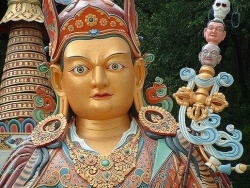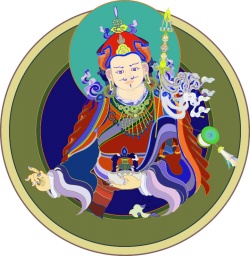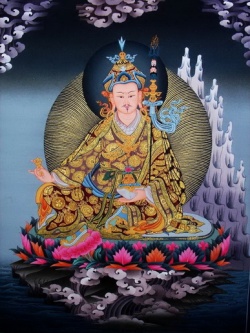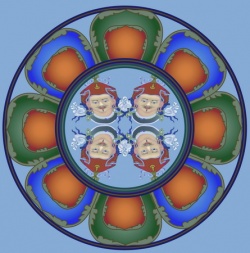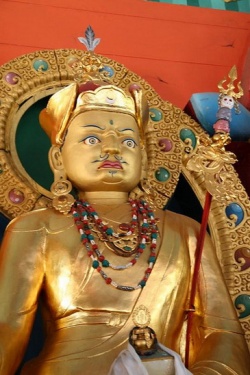The Esoteric Buddha and the Lotus-Born Guru
For 2,500 years Buddhists have considered with awe the achievement of Siddhartha Gautama. What induces such tremendous respect in them is not just that he gained Enlightenment, but that he did so without a teacher. (He learned meditation from Arada Kalama and Udraka Ramaputra, but neither of them could show him the way to escape from suffering - that he had to discover unaided.) Contemplating the difficulties that the Buddha had to overcome has given Buddhism a very great appreciation of the value of a spiritual teacher. As Buddhism developed, and the three yanas unfolded, the role and significance of the spiritual teacher changed.
In the first two yanas the teacher may act as a preceptor, responsible for introducing you to the Buddha way, or as a kalyana mitra - a spiritual friend. The kalyana mitra is like an older brother or sister in the Dharma, who helps, advises, and encourages. In the Vajrayana, the teacher transforms into the vajraguru. The relationship with a Tantric teacher is a samaya, or bond, at least as binding as that between the meditator and the Buddha or Bodhisattva that he or she visualizes. In Tantra it is said that all blessings spring from the guru. The relationship is more like that of a doctor with a patient who desperately wants a cure and has total belief in the doctor's method.
The guru is a (vajraguru partly because everything in the Tantra is vajra - everything is seen as an expression of the ineffable Reality of which the vajra is the chief Tantric symbol. The vajra prefix implies that the guru embodies Reality. He may formally teach the Dharma or he may not. However, just what he is expresses Reality. His being and mode of living are themselves a teaching. For his disciple, the communication of the Tantric guru may come as a thunderbolt. The vajraguru is spiritually ruthless. He is the teacher who will stop at nothing to awaken his disciple from the slumber of samsara.
There are many stories in the Tantra, as in Zen, of gurus using drastic methods to get through to their disciples. For the Tantric disciple, the guru's kindness can never be repaid. Through initiation the guru bestows practices which can propel the student rapidly to Buddhahood. The guru is the source, the fountainhead, of all his or her development. In fact, for the Tantra, particularly Highest Tantra, the guru is a Buddha. Ideally the guru should be Enlightened. Tantric initiation partly symbolizes the empowering of a far-advanced Bodhisattva with the full qualities of an Awakened One. Most gurus fall a long way short of full Enlightenment. Nonetheless, the Tantra is concerned with finding correlates in actual experience for the highest values of the spiritual path. As we saw in Chapter One, it says, in effect, 'If you are not in direct contact with a Buddha, who in your present experience comes closest to that level?'
The answer is, of course, your guru. So the guru becomes what is called the 'esoteric' Buddha Refuge. It is esoteric not in the sense of secret, but because it is not an experience that everyone can share. It is only if you enter into a close, devoted relationship with a teacher that he begins to function as a Buddha Refuge for you. It is also esoteric in the sense that it depends on an inner mental effort to see the guru in this way. Having received Tantric initiation from a teacher, the initiate is urged to make every effort to see the teacher as a fully Enlightened Buddha. He or she must disregard any apparent faults they may perceive in him or, rather, should attribute them to the impurity of their own mind.25 The Tantra holds firmly to the view that mind is king. If you see the guru as an ordinary person, you will receive the blessing of an ordinary person.
If you see him as a Buddha, for you he will act as a Buddha, and your relationship with him will lead you quickly to Enlightenment. Each school of Tibetan Buddhism has certain teachers whom it particularly reveres as the founders of its school, or for starting a particular lineage of teaching or initiation. Although they are historical figures, over the course of time they have taken on an archetypal significance. These teachers are frequently visualized, either during the practice of Guru Yoga or as part of the Refuge assemblies that we shall be looking at in Chapter Eight. We shall now look briefly at a few of the most important of these gurus.
(As usual, the number of figures one could describe is enormous.) We are going to begin by returning to the earliest sources of Tibetan Buddhism, to meet a figure who perhaps established an image of the vajraguru in the Tibetan mind, an image that helped to condition their understanding of the role of the Tantric guru in general. This is Padmasambhava ('lotus-born one'), known generally in Tibet as Guru Rimpoche ('precious guru'), and regarded as the founder of the Nyingma school of Tibetan Buddhism. We shall take him as an example of a vajraguru, describe some of his many forms, and say a little about how he can be meditated upon. This should convey something of the immense richness of symbolism and association surrounding these guru figures, built up over centuries of devotion.
Padmasambhava is a particularly complex 'spiritual personality', but in principle I could have taken almost any of the other gurus described in this chapter as examples of the multifaceted nature of the guru in the Vajrayana. Padmasambhava - the lotus-born guru Padmasambhava was instrumental in establishing Buddhism in Tibet in the eighth century. At that time King Trisong Detsen wanted to strengthen Buddhism, but was faced with fierce opposition from the Bonpos - followers of the indigenous shamanistic religion, led by a minister called Ma Zhang. A Buddhist abbot called Santaraksita was persuaded to come from Nepal, but though he achieved a certain amount, he could not overcome the Bonpos single-handed. They had been using witchcraft against him, so he recommended that the king invite Padmasambhava who, as well as being a master of Buddhist scholarship, was also a siddha, an adept in the psychic powers engendered by Tantric meditation.
Padmasambhava came to Tibet, and the great monastery of Samye was built with his assistance. He is represented subduing the local deities of Tibet by his magic power, and binding them by oath to be servants and protectors of the Dharma. There exists a truly extraordinary biography of Padmasambhava called The Life and Liberation of Padmasambhava. It describes how he is born as an emanation of the Buddha Amitabha, appearing spontaneously in a lotus on a lake in the country of Uddiyana. He is brought up by the king of that country as though he were his own son. Then, deciding it is time to leave the worldly life, he goes forth as a bhikshu.
He studies all aspects of Buddhism, as well as medicine and astrology. Next, he spends years meditating in all the great cremation grounds of India and the Himalayas. We are given graphic descriptions of the unspeakable horrors of these places. They are symbols for the endless fearful sufferings of conditioned existence itself. Yet in all these places Padmasambhava meditates unafraid, and converts the dakinis - who, if you understand the text literally, are flesh-eating demonesses. In a cemetery called Mysterious Paths of Beatitude he is initiated by an Enlightened dakini and receives supreme knowledge. All through his life he is a controversial figure. On at least two occasions his flouting of convention causes such outrage that people attempt to burn him to death. Yet each time he emerges unscathed - rising phoenix-like from the flames.
After performing his work of conversion in Tibet, he flies away to the land of the Raksasas (a race of ogres) to convert them too. Padmasambhava's biography is of an unequalled richness. It is one of the great spiritual documents of mankind. Within it, inner and outer events are so fused that it is frequently impossible to decide on what level of reality the events described took place. Are we watching actual events in the outside world - events which to us seem preternatural? Are we reliving Padmasambhava's visionary experiences? Is he - are we - dreaming? As presented in his life story, Padmasambhava becomes a kind of portmanteau figure - the embodiment in one person of all the accumulated knowledge, wisdom, love, and power of the Buddhist tradition.
He is a master of all secular arts and sciences, as well as of all three yanas of Buddhism. In this way he represents the guru par excellence, for a guru prepares himself for his task of communicating the Dharma by first making himself a receptacle of the Buddhist tradition. From his teachers he receives the nectar of the Dharma, handed down from teacher to disciple ever since Sakyamuni managed to communicate it to Kaundinya in the Deer Park at Sarnath. I am reminded of a scene from an old Hollywood film, in which at a party of the rich and famous there was a great pyramid of champagne glasses. A liveried waiter arrived with a great bottle of champagne and kept pouring it into the top glass. When this was full it overflowed, and the bubbling liquid filled each tier of glasses, down and down in a foaming cascade.
It is as though Sakyamuni Buddha is the top glass, who has made himself open to the transcendental. However, anyone who has absorbed the champagne brilliance of the Dharma cannot help but let it flow down to others. In this way, lineages of teaching are created. Padmasambhava represents the confluence of all these lineages - he is like a great crystal chalice in which all the bubbling streams of the Dharma meet. His life is also a symbolic recapitulation of the spread of the teaching. His transformations are its new developments. In the course of his story he takes on numerous different forms, and at each stage, with each fresh metamorphosis, he acquires a new name.
In this way he reminds us of two aspects of the guru. First, any guru worthy of the title has pursued his own development unremittingly. He has been prepared to undergo a number of spiritual deaths, and complete reorientations of consciousness, in his pursuit of the goal. The guru too, among his secondary characteristics, is a namer. In many cultures, entering a new stage of life entails a change of name. It is the guru who acts as guide as you enter upon the different stages of the spiritual path. Often, the guru will confer a new name upon you as you do so. This happens when you formally go for Refuge - when you ceremonially commit yourself to the Buddhist path. It happens if you leave home for the homeless life of a bhikshu or bhikshuni. It very often happens when you enter the mandala of the Vajrayana. In order to name something you have to understand its true
